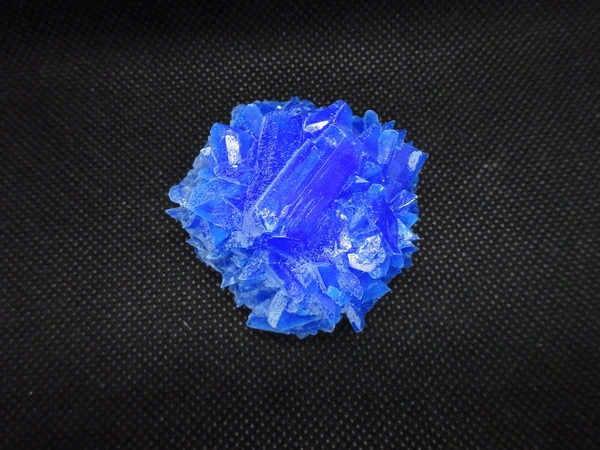Crystallization is a fundamental process in chemistry, widely used in laboratories and industries to purify substances. One of the most common examples of crystallization is the crystallization of copper sulfate, a process that demonstrates the formation of pure solid crystals from a solution. In this guide, we will explore every aspect of the crystallization of copper sulfate, from the principles behind it to the procedure, factors affecting crystal growth, and applications of the process.
Introduction to Crystallization

Crystallization of copper sulfate is a separation technique used to obtain pure solid substances from a solution. It involves the formation of a well-defined crystal structure when a solution becomes supersaturated. The process is driven by changes in temperature, concentration, or solvent properties, leading to the formation of solid particles with an orderly internal arrangement.
Materials Required for the Crystallization of Copper Sulfate

To conduct the crystallization process of copper(II) sulfate pentahydrate (CuSO₄·5H₂O) in a laboratory setting, you will need the following materials:
- Copper sulfate (CuSO₄) powder or crystals
- Distilled water
- Beaker (250 mL or more)
- Glass rod (for stirring)
- Heating apparatus (Bunsen burner or hot plate)
- Filter paper and funnel
- Evaporating dish
- Watch glass
- String or thread (for large crystals)
- Cooling setup (optional)
Procedure for Crystallization of Copper Sulfate
Step 1: Preparation of the Copper Sulfate Solution
- Measure approximately 100 mL of distilled water into a clean beaker.
- Add copper sulfate powder gradually while stirring continuously.
- Keep adding copper sulfate until no more dissolves, indicating that the solution is saturated.
Step 2: Heating the Solution

- Place the beaker on a heating apparatus and gently heat the solution while stirring to dissolve the remaining copper sulfate.
- Avoid boiling the solution, as it may lead to unwanted evaporation of water.
Step 3: Filtration
- Filter the hot solution using filter paper and a funnel to remove impurities and undissolved particles.
- Collect the clear filtrate in a clean beaker or evaporating dish.
Step 4: Cooling and Crystal Formation
- Allow the filtered solution to cool gradually at room temperature.
- As the temperature drops, copper sulfate crystals start forming due to reduced solubility.
Step 5: Harvesting the Crystals

- Once significant crystal formation is observed, carefully decant the excess solution.
- Remove the crystals and dry them by placing them on filter paper.
- For larger crystals, suspend a string or thread in the solution and allow slow crystal growth over days.
Factors Affecting the Crystallization of Copper Sulfate
Several factors influence the crystallization of copper sulfate, including:
1. Temperature
- Higher temperatures increase the solubility of CuSO₄, allowing more to dissolve.
- Slow cooling leads to larger, well-defined crystals, while rapid cooling produces small, irregular crystals.
2. Rate of Evaporation
- The gradual evaporation of the solvent leads to the formation of larger crystals in a controlled fashion.
- Fast evaporation leads to small, imperfect crystals.
3. Purity of the Solution
- Impurities hinder proper crystal formation.
- Filtering ensures pure and well-formed crystals.
4. Presence of Nucleation Sites
- Dust particles or pre-existing crystals act as seeds for new crystal growth.
- Using a thread or rough surface can help control nucleation.
Applications of Copper Sulfate Crystals

The crystallization of copper sulfate has significant applications in various fields, including:
1. Educational Demonstrations
- Used in chemistry labs to demonstrate solubility, supersaturation, and crystal formation principles.
2. Industrial Uses
- Purification of copper sulfate for use in agriculture (fungicides), electroplating, and dye manufacturing.
3. Art and Decoration
- Beautiful blue copper sulfate crystals are used in jewelry and decorative materials.
4. Electrochemical Applications
- Copper sulfate solutions are widely used in electrolysis and battery applications.
Common Errors in the Crystallization of Copper Sulfate
1. Crystals Not Forming
Solution: Ensure the solution is saturated. Try slow cooling or seeding the solution with a small crystal.
2. Formation of Impure Crystals
Solution: Use high-purity copper sulfate and filter the solution thoroughly before cooling.
3. Very Small Crystals
Solution: Control the rate of evaporation and cooling. Slow cooling results in larger crystals.
4. Loss of Water in Crystals
Solution: Store crystals in an airtight container to prevent dehydration, which can lead to powdering.
Conclusion
The crystallization of copper sulfate is a simple yet fascinating chemical process that demonstrates key principles of solubility and crystal growth. Whether performed in a laboratory, industry, or as an educational experiment, understanding the influencing factors ensures the successful formation of well-defined crystals.
How is the crystallization of copper sulfate prepared?
What is Crystallization?

Crystallization of copper sulfate is a separation technique used to obtain pure solid substances from a solution. It involves the formation of a well-defined crystal structure when a solution becomes supersaturated. The process is driven by changes in temperature, concentration, or solvent properties, leading to the formation of solid particles with an orderly internal arrangement.
Materials Required for the Crystallization of Copper Sulfate

To conduct the crystallization process of copper(II) sulfate pentahydrate (CuSO₄·5H₂O) in a laboratory setting, you will need the following materials:
Copper sulfate (CuSO₄) powder or crystals
Distilled water
Beaker (250 mL or more)
Glass rod (for stirring)
Heating apparatus (Bunsen burner or hot plate)
Filter paper and funnel
Evaporating dish
Watch glass
String or thread (for large crystals)
Cooling setup (optional)
Procedure for Crystallization of Copper Sulfate
Step 1: Preparation of the Copper Sulfate Solution
Measure approximately 100 mL of distilled water into a clean beaker.
Add copper sulfate powder gradually while stirring continuously.
Keep adding copper sulfate until no more dissolves, indicating that the solution is saturated.
Step 2: Heating the Solution

Place the beaker on a heating apparatus and gently heat the solution while stirring to dissolve the remaining copper sulfate.
Avoid boiling the solution, as it may lead to unwanted evaporation of water.
Step 3: Filtration
Filter the hot solution using filter paper and a funnel to remove impurities and undissolved particles.
Collect the clear filtrate in a clean beaker or evaporating dish.
Step 4: Cooling and Crystal Formation
Allow the filtered solution to cool gradually at room temperature.
As the temperature drops, copper sulfate crystals start forming due to reduced solubility.
Step 5: Harvesting the Crystals

Once significant crystal formation is observed, carefully decant the excess solution.
Remove the crystals and dry them by placing them on filter paper.
For larger crystals, suspend a string or thread in the solution and allow slow crystal growth over days.
Factors Affecting the Crystallization of copper sulfate
Several factors influence the crystallization of copper sulfate, including:
1. Temperature
Higher temperatures increase the solubility of CuSO₄, allowing more to dissolve.
Slow cooling leads to larger, well-defined crystals, while rapid cooling produces small, irregular crystals.
2. Rate of Evaporation
The gradual evaporation of the solvent leads to the formation of larger crystals in a controlled fashion.
Fast evaporation leads to small, imperfect crystals.
3. Purity of the Solution
Impurities hinder proper crystal formation.
Filtering ensures pure and well-formed crystals.
4. Presence of Nucleation Sites
Dust particles or pre-existing crystals act as seeds for new crystal growth.
Using a thread or rough surface can help control nucleation.
Applications of Copper Sulfate Crystals

The crystallization of copper sulfate has significant applications in various fields, including:
1. Educational Demonstrations
Used in chemistry labs to demonstrate solubility, supersaturation, and crystal formation principles.
2. Industrial Uses
Purification of copper sulfate for use in agriculture (fungicides), electroplating, and dye manufacturing.
3. Art and Decoration
Beautiful blue copper sulfate crystals are used in jewelry and decorative materials.
4. Electrochemical Applications
Copper sulfate solutions are widely used in electrolysis and battery applications.
Common errors in Crystallization of Copper Sulfate
1. Crystals Not Forming
Solution: Ensure the solution is saturated. Try slow cooling or seeding the solution with a small crystal.
2. Formation of Impure Crystals
Solution: Use high-purity copper sulfate and filter the solution thoroughly before cooling.
3. Very Small Crystals
Solution: Control the rate of evaporation and cooling. Slow cooling results in larger crystals.
4. Loss of Water in Crystals
Solution: Store crystals in an airtight container to prevent dehydration, which can lead to powdering.
Conclusion
The crystallization of copper sulfate is a simple yet fascinating chemical process that demonstrates key principles of solubility and crystal growth. Whether performed in a laboratory, industry or as an educational experiment, understanding the influencing factors ensures the successful formation of well-defined
What is the result of the crystallization of copper sulfate?
What is Crystallization?
Crystallization is a separation technique used to obtain pure solid substances from a solution. It involves the formation of a well-defined crystal structure when a solution becomes supersaturated. The process is driven by changes in temperature, concentration, or solvent properties, leading to the formation of solid particles with an orderly internal arrangement.
Materials Required for the Crystallization of Copper Sulfate
To conduct the crystallization of copper(II) sulfate pentahydrate (CuSO₄·5H₂O) in a laboratory setting, you will need the following materials:
Copper sulfate (CuSO₄) powder or crystals
Distilled water
Beaker (250 mL or more)
Glass rod (for stirring)
Heating apparatus (Bunsen burner or hot plate)
Filter paper and funnel
Evaporating dish
Watch glass
String or thread (for large crystals)
Cooling setup (optional)
Procedure for Crystallization of Copper Sulfate
Step 1: Preparation of the Copper Sulfate Solution
Measure approximately 100 mL of distilled water into a clean beaker.
Add copper sulfate powder gradually while stirring continuously.
Keep adding copper sulfate until no more dissolves, indicating that the solution is saturated.
Step 2: Heating the Solution
Place the beaker on a heating apparatus and gently heat the solution while stirring to dissolve the remaining copper sulfate.
Avoid boiling the solution, as it may lead to unwanted evaporation of water.
Step 3: Filtration
Filter the hot solution using filter paper and a funnel to remove impurities and undissolved particles.
Collect the clear filtrate in a clean beaker or evaporating dish.
Step 4: Cooling and Crystal Formation
Allow the filtered solution to cool gradually at room temperature.
As the temperature drops, copper sulfate crystals start forming due to reduced solubility.
Step 5: Harvesting the Crystals
Once significant crystal formation is observed, carefully decant the excess solution.
Remove the crystals and dry them by placing them on filter paper.
For larger crystals, suspend a string or thread in the solution and allow slow crystal growth over days.
Factors Affecting the Crystallization Process
Several factors influence the crystallization of copper sulfate, including:
1. Temperature
Higher temperatures increase the solubility of CuSO₄, allowing more to dissolve.
Slow cooling leads to larger, well-defined crystals, while rapid cooling produces small, irregular crystals.
2. Rate of Evaporation
The gradual evaporation of the solvent leads to the formation of larger crystals in a controlled fashion.
Fast evaporation leads to small, imperfect crystals.
3. Purity of the Solution
Impurities hinder proper crystal formation.
Filtering ensures pure and well-formed crystals.
4. Presence of Nucleation Sites
Dust particles or pre-existing crystals act as seeds for new crystal growth.
Using a thread or rough surface can help control nucleation.
Applications of Copper Sulfate Crystals
The crystallization of copper sulfate has significant applications in various fields, including:
1. Educational Demonstrations
Used in chemistry labs to demonstrate solubility, supersaturation, and crystal formation principles.
2. Industrial Uses
Purification of copper sulfate for use in agriculture (fungicides), electroplating, and dye manufacturing.
3. Art and Decoration
Beautiful blue copper sulfate crystals are used in jewelry and decorative materials.
4. Electrochemical Applications
Copper sulfate solutions are widely used in electrolysis and battery applications.
Common Issues and Troubleshooting in Copper Sulfate Crystallization
1. Crystals Not Forming
Solution: Ensure the solution is saturated. Try slow cooling or seeding the solution with a small crystal.
2. Formation of Impure Crystals
Solution: Use high-purity copper sulfate and filter the solution thoroughly before cooling.
3. Very Small Crystals
Solution: Control the rate of evaporation and cooling. Slow cooling results in larger crystals.
4. Loss of Water in Crystals
Solution: Store crystals in an airtight container to prevent dehydration, which can lead to powdering.
Conclusion
The crystallization of copper sulfate is a simple yet fascinating chemical process that demonstrates key principles of solubility and crystal growth. Whether performed in a laboratory, industry or as an educational experiment, understanding the influencing factors ensures the successful formation of well-defined crystals.
How to crystallize copper sulfate in class 9th?
What is Crystallization?

Crystallization of copper sulfate is a separation technique used to obtain pure solid substances from a solution. It involves the formation of a well-defined crystal structure when a solution becomes supersaturated. The process is driven by changes in temperature, concentration, or solvent properties, leading to the formation of solid particles with an orderly internal arrangement.
Materials Required for the Crystallization of Copper Sulfate

To conduct the crystallization process of copper(II) sulfate pentahydrate (CuSO₄·5H₂O) in a laboratory setting, you will need the following materials:
Copper sulfate (CuSO₄) powder or crystals
Distilled water
Beaker (250 mL or more)
Glass rod (for stirring)
Heating apparatus (Bunsen burner or hot plate)
Filter paper and funnel
Evaporating dish
Watch glass
String or thread (for large crystals)
Cooling setup (optional)
Procedure for Crystallization of Copper Sulfate
Step 1: Preparation of the Copper Sulfate Solution
Measure approximately 100 mL of distilled water into a clean beaker.
Add copper sulfate powder gradually while stirring continuously.
Keep adding copper sulfate until no more dissolves, indicating that the solution is saturated.
Step 2: Heating the Solution

Place the beaker on a heating apparatus and gently heat the solution while stirring to dissolve the remaining copper sulfate.
Avoid boiling the solution, as it may lead to unwanted evaporation of water.
Step 3: Filtration
Filter the hot solution using filter paper and a funnel to remove impurities and undissolved particles.
Collect the clear filtrate in a clean beaker or evaporating dish.
Step 4: Cooling and Crystal Formation
Allow the filtered solution to cool gradually at room temperature.
As the temperature drops, copper sulfate crystals start forming due to reduced solubility.
Step 5: Harvesting the Crystals

Once significant crystal formation is observed, carefully decant the excess solution.
Remove the crystals and dry them by placing them on filter paper.
For larger crystals, suspend a string or thread in the solution and allow slow crystal growth over days.
Factors Affecting the Crystallization of copper sulfate
Several factors influence the crystallization of copper sulfate, including:
1. Temperature
Higher temperatures increase the solubility of CuSO₄, allowing more to dissolve.
Slow cooling leads to larger, well-defined crystals, while rapid cooling produces small, irregular crystals.
2. Rate of Evaporation
The gradual evaporation of the solvent leads to the formation of larger crystals in a controlled fashion.
Fast evaporation leads to small, imperfect crystals.
3. Purity of the Solution
Impurities hinder proper crystal formation.
Filtering ensures pure and well-formed crystals.
4. Presence of Nucleation Sites
Dust particles or pre-existing crystals act as seeds for new crystal growth.
Using a thread or rough surface can help control nucleation.
Applications of Copper Sulfate Crystals

The crystallization of copper sulfate has significant applications in various fields, including:
1. Educational Demonstrations
Used in chemistry labs to demonstrate solubility, supersaturation, and crystal formation principles.
2. Industrial Uses
Purification of copper sulfate for use in agriculture (fungicides), electroplating, and dye manufacturing.
3. Art and Decoration
Beautiful blue copper sulfate crystals are used in jewelry and decorative materials.
4. Electrochemical Applications
Copper sulfate solutions are widely used in electrolysis and battery applications.
Common errors in Crystallization of Copper Sulfate
1. Crystals Not Forming
Solution: Ensure the solution is saturated. Try slow cooling or seeding the solution with a small crystal.
2. Formation of Impure Crystals
Solution: Use high-purity copper sulfate and filter the solution thoroughly before cooling.
3. Very Small Crystals
Solution: Control the rate of evaporation and cooling. Slow cooling results in larger crystals.
4. Loss of Water in Crystals
Solution: Store crystals in an airtight container to prevent dehydration, which can lead to powdering.
Conclusion
The crystallization of copper sulfate is a simple yet fascinating chemical process that demonstrates key principles of solubility and crystal growth. Whether performed in a laboratory, industry or as an educational experiment, understanding the influencing factors ensures the successful formation of well-defined crystals.

2 thoughts on “Crystallization of copper sulfate”